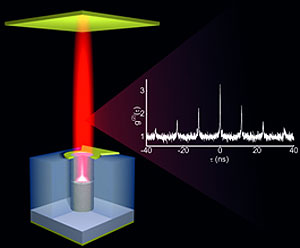Physicists from the University of Würzburg have used special nanostructures known as quantum dots in microlasers to trigger chaos in the light emission process. This can become a new and safe method to transmit data in the future.
 A quantum dot microlaser emits light that is deliberately cast back into the laser via a mirror. This disturbs the laser’s operation so much so that the emission behavior becomes chaotic.Image Credit: Ferdinand Albert
A quantum dot microlaser emits light that is deliberately cast back into the laser via a mirror. This disturbs the laser’s operation so much so that the emission behavior becomes chaotic.Image Credit: Ferdinand Albert
Stephan Reitzenstein and his colleagues at the University of Würzburg’s Institute of Physics along with their Israeli coworker Ido Kanter used a tiny laser to continuously send back a part of the light emitted to the laser. This distrubed the light emission and the microlaser began emitting photons in a disorderly pulse sequence. Reitzenstein said that this targeted feedback might be of use in optical amplifiers and switches in the future and also added that the long distance negative feedback from two microlasers will probably synchronize the cluttered pulse sequence, thus offering a novel safe form of data transmission.
The microlasers, which were electrically driven, have a peculiar sequence of very thin layers of semiconductors and looked like small towers. Quantum dots, which emit light, were kept at the microlasers’ center during production. Reitzenstein says that the microlasers are designed to couple the photons emitted by the quantum dots into the lasing mode, which can be used in high-efficiency laser operation. The microlasers produced at Würzburg need only a few microamperes and about 10 quantum dots for functioning whereas standard semiconductor lasers require milliampere range currents and around 1,000 to 10,000 quantum dots.
The advanced quantum dot microlasers are highly sensitive to changes the amount of photon emitted and even a single photon emission can disturb the operation of the laser. Reitzenstein said that complex photon statistics were needed to observe the chaotic behavior and they proved that disturbed laser led to an irregular pulse sequence in which every light pulse had around 100 photons.
Reitzenstein stated that extensive research is being carried out globally to produce the ultimate micro- or nanolaser, which will need only one quantum dot to function. He also added that they are currently working on synchronizing two lasers to the extent that only one photon will be moving back and forth and this will help in a new level of synchronization and a secure method of data transmission.